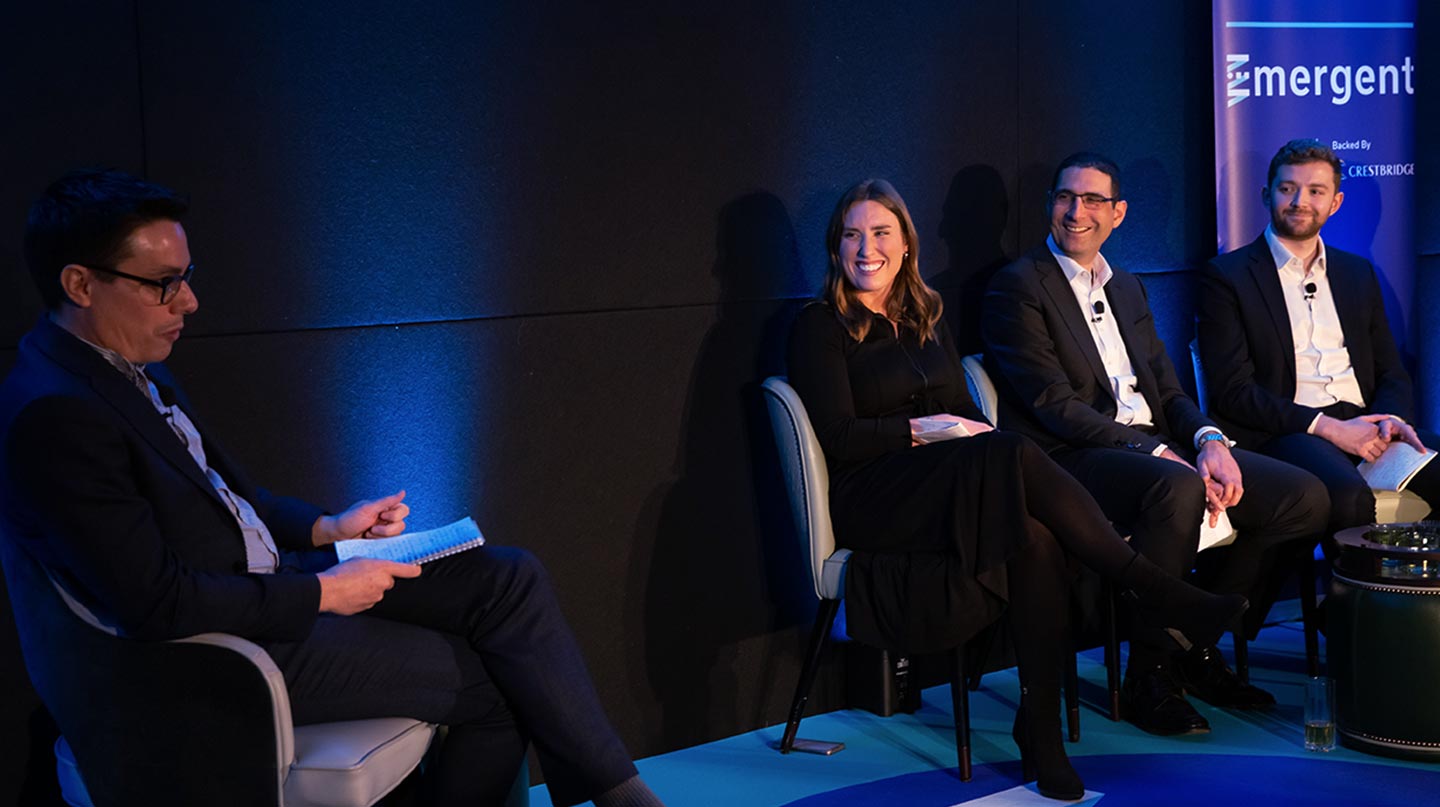
Emergent, held at a chic location in central London, The Mayfair Townhouse, is part of Crestbridge’s outreach and support of emerging managers

Director at Material Impact Marketing Communications
I recently had the privilege of attending a panel discussion on ESG hosted by Emergent, a platform that brings together emerging managers across the alternative asset management spectrum, for professional networking and knowledge sharing.
The event, held at a chic location in central London, The Mayfair Townhouse, is part of the organisation’s outreach and support of emerging managers raising their inaugural fund or seeking to spin out of an established firm. Our hostess for the evening, Nicola Nicholson, Head of Marketing for Crestbridge and founder of Emergent, was gracious and engaging, creating a welcoming atmosphere and setting the stage for an enjoyable and informative evening.
The panel comprised Jessica Stewart from Systemiq Capital, Daniel Greenway from K&L Gates, Robert Dangell from Bethnal Green Ventures and Yudi Singh from Future Business Partnership and chaired by Alex Di Santo from Crestbridge, a fund administration group.


Audience Q&A session. There were around 30 people in attendance, from companies ranging from investors in hydrogen technology through to infrastructure investors, lawyers and other professional advisors.
The panel comprised Jessica Stewart from Systemiq Capital, Daniel Greenway from K&L Gates, Robert Dangell from Bethnal Green Ventures and Yudi Singh from Future Business Partnership and chaired by Alex Di Santo from Crestbridge, a fund administration group.
There were around 30 people in attendance, from companies ranging from investors in hydrogen technology through to infrastructure investors, lawyers and other professional advisors. Throughout the session, the panellists offered a diverse array of perspectives on various topics related to ESG and impact investing, including the difference between these two widely proliferated labels, the management of expectations surrounding data collection and reporting, financial incentivisation for impact, and the importance of decarbonisation. Despite the diverse nature of the discussions, the event was able to capture the collective essence of these topics and provided an excellent platform for thoughtful discussion and learning.
Rather sensibly, the panel started with a definition of ESG and impact investing. It defined ESG as “the process and internal practices of a company,” while impact investing as the “social and environmental outcomes of a company’s operations.” Whilst these are good definitions, these ESG ratings are not always straightforward.
In many cases, the ratings are split into separate scores for each component, which can lead to seemingly contradictory results. The panel discussed how a company like British American Tobacco or Exxon may have a high ESG rating due to their use of renewable energy or diverse board, but their environmental impact is still questionable. On the other hand, a company like Tesla, which is known for its positive environmental impact in switching to electric vehicles, may have lower ESG scores due to concerns about its corporate governance. In this sense, it can feel like the current system of ESG scoring is at best oversimplified and at worst, a bit of a wild west, where not everything is as it may seem and no apparent Clint Eastwood is jumping out to save the day.
The panellists’ emphasis on the importance of embedding ESG frameworks into a firm’s DNA rather than treating it as a mere tick box exercise for potential LPs struck a chord with me. To truly start the ESG journey, companies need to commit to weaving ESG practices into their very fabric. This means having a board of advisors and governance board that can provide guidance and keep managers accountable. Policies alone won’t cut it, and cultivating a culture that values ESG practices is crucial. By taking a holistic approach and working towards a common goal, companies can implement effective ESG practices that benefit not only themselves but also society at large. It’s about more than just ticking a box – it’s about making a genuine commitment to creating positive change.
Each guest received a complimentary copy of the Emerging Fund Managers Guide published by Emergent.


The panellists’ emphasis on the importance of embedding ESG frameworks into a firm’s DNA rather than treating it as a mere tick box exercise for potential LPs.
As the investment landscape shifts towards more ethical and sustainable practices, investors are increasingly scrutinising ESG scores and the reality of a company’s progress towards positive impact. As the saying goes, the arc of the moral universe may be long, but it does lean towards good governance and positive impact.
Yet, the journey towards effective ESG practices varies across different jurisdictions. According to Daniel Greenway from K&L Gates, big pension funds are leading the way in ESG practices, particularly in the areas of diversity, inclusion, and the environment. However, in the US, ESG practices are lagging. European investors, on the other hand, are somewhere in the middle, with some being drawn towards the SFDR kite mark, which is intended as a stamp of approval for funds with strong ESG practices, but not created for that purpose.
Investor due diligence has also become more detailed in recent years, with LPs asking for ESG reporting and monitoring and even non-impact funds facing scrutiny. This reflects a growing awareness among investors about the importance of ESG practices and a shift away from box-ticking.
This desire to make investments with companies and managers that are actually moving the needle when it comes to ESG and positive impact, leads investors to request data… and lots of it. The panel noted that everybody wants best in class data, but extracting and collating that data can be a time-consuming process that requires managing expectations from the start. Some investors have implemented a framework for collecting data from portfolio companies, outlining expectations at the outset of the agreement. While some investors aim for quarterly data collection, others prioritise quality over quantity and opt for an annual cycle.
In addition to data collection, investors are also seeking alignment with their investors. One option is encouraging companies to become a B-Corp, which provides a framework for ESG practices and can be mapped against various frameworks, such as the UN SDGs. While implementing ESG practices is a challenge for boards, having a framework in place can help measure against certain sets of data and facilitate alignment with investors.
As ESG practices continue to gain importance, investors will need to balance the challenge of data collection and expectations management with the benefits of ESG alignment and framework implementation.
According to the panel, investing in companies that have a positive impact on climate change can be easier in some ways than traditional investing. The KPIs for climate impact are often similar to financial KPIs and the founders are typically willing to track these metrics since they are critical to the company’s success. However, it is crucial to set expectations upfront during diligence and term sheet negotiations to ensure that the necessary data is collected.
Monitoring progress can be challenging, especially for early-stage companies, since board access and information can be limited. Quarterly reporting can also be difficult for companies that are focused on staying afloat. Investors must balance the need for data with the need to be mindful of a company’s struggles.
Financial incentivisation for impact is a topic of conversation among investors, but it can be challenging to implement. One hurdle is the potential conflict of interest when measuring impact for one’s own investments. Another issue is that impact carry may be lower than traditional carry, which can affect investor interest.
One way investors are incentivising impact is by tying management fees to deliverables. However, it can be difficult to determine what qualifies as an impact deliverable, and there is debate over whether this approach is effective.
To address these challenges, some investors are turning to frameworks like B Corp certification, which provides a transparent and easily trackable way to measure impact. For example, one investment firm has implemented B Corp certification to align with their values and provide transparency for investors.
While financial incentivisation for impact is still a work in progress, frameworks like B Corp certification offer a promising solution for investors looking to make a positive impact on the world while achieving their financial goals. As the ESG landscape continues to evolve, investors will need to remain flexible and open-minded to new approaches to impact investing.
——
Material Impact Marketing Communications makes brands more visible and valuable by helping firms tell their stories with impact. We specialise in PR and marketing services for asset managers looking to build, raise or protect their public profile. Our team provides comprehensive support, including media relations, brand development and thought leadership strategy.